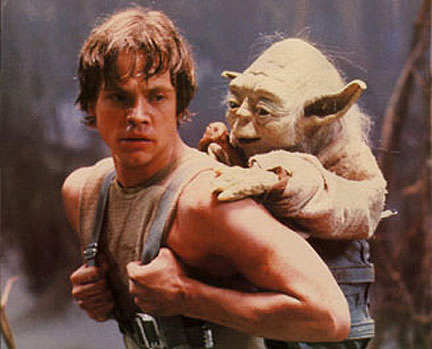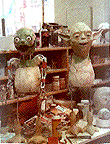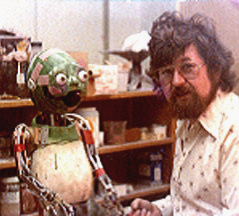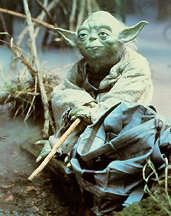Nick Maley continues his insights
into the creation of the
STAR
WARS creatures with the
second file in his series about creating
Yoda. You
should read
part
one before
this........
Ergo
The making of Yoda, Part
II.
Ergo: So what separates
part I
from part II ?
Nick: The making of Yoda part
I concentrated upon background information about the design,
the principle people involved and the construction of the first
puppet. Part II relates to several other
versions of Yoda that were made to suit
specific shots and circumstances.
Ergo: Such as ?
 Nick: It was decided that a
second version was needed specifically for the sequence where
Yoda is in
Luke's back pack. The glove puppet was
good for the close-ups where you were too close to see
Frank Oz hidden
behind
Mark
Hamill. But for the longer
shots of Luke running, walking etc. and where
Yoda is balanced on Luke's foot,
they needed a radio controlled version. At that time the make-up
effects department did nothing that was radio controlled..... it was
more than a year before Bob Keen
and I started experimenting with that for an animatronic bear suit
for THREE ON THE
RUN, an ill fated TV pilot.
Nick: It was decided that a
second version was needed specifically for the sequence where
Yoda is in
Luke's back pack. The glove puppet was
good for the close-ups where you were too close to see
Frank Oz hidden
behind
Mark
Hamill. But for the longer
shots of Luke running, walking etc. and where
Yoda is balanced on Luke's foot,
they needed a radio controlled version. At that time the make-up
effects department did nothing that was radio controlled..... it was
more than a year before Bob Keen
and I started experimenting with that for an animatronic bear suit
for THREE ON THE
RUN, an ill fated TV pilot.
Ron
Hone was working
with
Nick
Allder in the Physical Special Effects Department. He was
supervising robot fabrication and he was the natural choice to build
the two radio control mechanisms.
 Ergo: Two
mechanisms ?
Ergo: Two
mechanisms ?
Nick: One was a back-up. You don't want to wait till
something breaks down before you start assembling another. That would
take too long. Since the mechanism was the slowest part (once the
modeling and molding were complete) of assembling the rc puppet, Ron
built two. In fact only one was needed.
Ergo: Were these like complete little robots that could
walk around?
Nick: No. That wasn't necessary. Part of an HOD's job in
not allowing the budget to get entirely out of control is to decide
what is needed to get the shot and not spend a lot of money on
features no one will ever see. Besides, making a robot that walks
naturally is a huge task. The arms and legs were static and could be
wired into any position to suit the shot. The eyes, eyelids, jaw and
neck were radio controlled and the whole thing was self contained. It
fitted perfectly in Luke's backpack.
Mark could move freely while the operator was across the set
somewhere.
Stuart (Freeborn) was very
caught up building the intricate brass mechanism for the first
puppet. So he asked me to fit the skins I had produced to the
mechanisms Ron had built. The hair was punched in (as it was on all
the Yoda puppets) by
Graham Freeborn and myself and then
it was artworked.
Ergo: What do you mean by "punched in" ?
Nick: Well, there are two traditional methods of applying
hair. The first is to make a wig, either from wefting or by knotting
the hair, onto a shaped lace base, 3 or 4 hairs at a time. The second
is to glue the hairs individually directly to the actor, mask or
puppet... that system is known as "laying loose hair". Neither were
suitable in this case. Loose hair was too delicate for a puppet that
was used constantly for weeks and the hair was too whispy to use a
conventional wig.
 On
2001 - A SPACE
ODYSSEY, Stuart
(Freeborn) had used an alternative system for the hair on the ape
masks. I don't know for sure that he invented it but I think he may
well have. Bails of synthetic (hair like) thread were threaded
through hypodermic needles and punched right into the skin itself one
hair at a time. On STAR
WARS we used real hair and had to re-thread the needles on every
strand.
On
2001 - A SPACE
ODYSSEY, Stuart
(Freeborn) had used an alternative system for the hair on the ape
masks. I don't know for sure that he invented it but I think he may
well have. Bails of synthetic (hair like) thread were threaded
through hypodermic needles and punched right into the skin itself one
hair at a time. On STAR
WARS we used real hair and had to re-thread the needles on every
strand.
Ergo: You mean you had to thread every hair through the eye
of a needle before you could attach it to the head ?
Nick: Worse really, we were threading it through the full
length of the shaft of a hypodermic where the fluid passes during an
injection.
Ergo: Unbelievable!
Nick: We used the process extensively on
Chewbacca and
Yoda.
 Ergo: Were there any other versions of
Yoda that were made to suit a specific
shot ?
Ergo: Were there any other versions of
Yoda that were made to suit a specific
shot ?
Nick: There was a double size version which had a midget
inside for one shot at the end of Luke's
first encounter with Yoda........ where
you see him walking away through the swamp.
Ergo: Was Kenny Baker in
that?
Nick: No, Kenny is a dwarf and his proportions weren't
suitable. A midget is small but in proportion with normal people. I
think we used
Deep
Roy for that shot.
Ergo: Who made that ?
Nick: I did. I used Di-iso-Octyl Phthalate suspended in
Iso-proyl alcohol to expand a regular sized skin up to twice the
normal size.
Ergo: So you have to be a chemist as well as everything
else.
 Nick: Absolutely.
Nick: Absolutely.
At that time we were using Windsor
Hills foam and that was very sensitive to many materials.....
so chemical expansion was a quick solution to the problem. Punching
the hair into an ultra weak skin was very tricky but fortunately the
figure was a long way away. Artworking the rather oily skin was
difficult too.
Ergo: So you assembled two versions of
Yoda.
Nick: Actually no. There is another puppet that we haven't
discussed yet.
Ergo: ?
Nick: :-)
Ergo: I guess that brings us to
the Making of Yoda
Part III!
If you were looking for
something totally unique.........You found it!
Nick's
CineSecrets®
........You make
movies?
click
here
.......Nick's
Art Online
text © CineSecrets 97/98
This link is
for
"No
Frames"
users only
Index
of indexes Don't try it with
frames.

 Nick: It was decided that a
second version was needed specifically for the sequence where
Yoda is in
Luke's back pack. The glove puppet was
good for the close-ups where you were too close to see
Frank Oz hidden
behind
Mark
Hamill. But for the longer
shots of Luke running, walking etc. and where
Yoda is balanced on Luke's foot,
they needed a radio controlled version. At that time the make-up
effects department did nothing that was radio controlled..... it was
more than a year before Bob Keen
and I started experimenting with that for an animatronic bear suit
for THREE ON THE
RUN, an ill fated TV pilot.
Nick: It was decided that a
second version was needed specifically for the sequence where
Yoda is in
Luke's back pack. The glove puppet was
good for the close-ups where you were too close to see
Frank Oz hidden
behind
Mark
Hamill. But for the longer
shots of Luke running, walking etc. and where
Yoda is balanced on Luke's foot,
they needed a radio controlled version. At that time the make-up
effects department did nothing that was radio controlled..... it was
more than a year before Bob Keen
and I started experimenting with that for an animatronic bear suit
for THREE ON THE
RUN, an ill fated TV pilot. Ergo: Two
mechanisms ?
Ergo: Two
mechanisms ? On
On
 Ergo: Were there any other versions of
Yoda that were made to suit a specific
shot ?
Ergo: Were there any other versions of
Yoda that were made to suit a specific
shot ? Nick: Absolutely.
Nick: Absolutely.